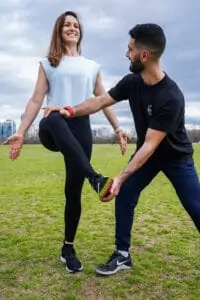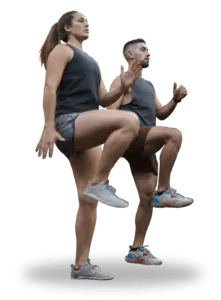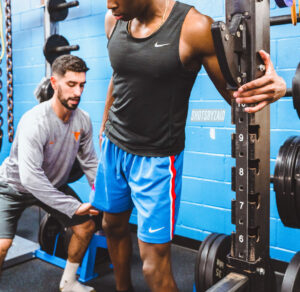From improving coordination to boosting explosiveness, there’s no doubt that full-body movement, or functional training, has its benefits.
However, there is a type of training that is underrated (but absolutely crucial) in building a balanced body:
Unilateral training is different from pure isolation exercises, and is something we tend to forget about unless we’re in some type of therapy or physical rehab. However, this type of training should be a staple in our regular regime for many awesome reasons!
What Is Unilateral Training?

Unilateral training is training that utilizes single-leg or single-arm exercises (think side planks, single-arm rows, single-leg step ups, etc …). In essence, it focuses on one area/parallel side of the body at a time.
While functional, whole-body training is amazing and should definitely be fully integrated into your regime, unilateral training plays a special role in strengthening specific areas of your body, as well as correcting imbalances and weaknesses. In fact, this is an important first step in the training process, since you want to bring the body into balance alongside improving holistic strength and coordination!
Let’s dive in deeper.
Unilateral Movements: The Benefits
1. Corrects Imbalances
Most people have a dominant side that tends to be more coordinated or stronger than the other. If you’re right-handed, for instance, you may feel your right arm or leg is more coordinated than your left. Because of this, you will often unconsciously use your right arm or leg more than your left … which can cause the right side to be stronger overall. Now, this doesn’t sound like a huge problem on the surface, but over time your body will begin to compensate during certain movements, causing your left side to not only become weaker, but also place more pressure on the right side.
Unilateral movements strengthen each side individually so that your body is unable to compensate, or rely on, the stronger side.
For instance, when you are actively taking a muscle group through a pattern like an overhead press, it is easier to highlight the contra-lateral side of the body when you are performing the press, so you lean over to a side to compensate for the strength in that position. Therefore, going through the drill with good intentions of keeping the stability and pressing effort of your feet into the ground and allowing a slight, subtle and articulated rotation to allow for a unilateral press.
It’s an art of allowing some movement of the spine and limbs when pressing/hinging/pulling/etc … but also not so much that it forces other areas of the body to cause pain or discomfort
Or, to put it simply, you’ll be firing on all cylinders, in full balance!
Plus, focusing on one part or side of the body at a time allows you to fully concentrate on the weak area, which can be more difficult when you’re doing compound movements.
2. Can Help With Joint Pain And Rehabilitation

Correcting imbalances or weaknesses in one side of your body may also help with aches, pains, and stiffness. When our bodies compensate for a weak area, the muscles or joints doing the compensating are taking on more pressure and/or friction … which can lead to pain over time. When weak areas are strengthened, this pressure is relieved, which can lessen pain.
Additionally, unilateral training has been used in rehabilitation, based on the idea that when you train one side of the body, the other side is also stimulated. This is referred to as cross-education – when one side is injured, the link between sides can act as a bridge to stimulate gains on the opposing side.
3. May Boost Performance
While it’s true that most sport’s rely on whole-body coordination, we often forget that they rely equally on unilateral movements. In many sports, for instance, power and rapid changes of direction rely on one leg at a time (think of a sprinter exploding off the starting line: one leg is unleashing much of the force). When both legs are of equal strength (the same can be said for the obliques, arms, etc…) your power and explosiveness will be optimal on all sides of your body.
This means that you’ll be putting your best foot forward … with both feet!
4. Can Help Mitigate Injuries
As we mentioned earlier, when one side of your body is weak, the stronger side compensates for the weakness. This is fine in the short term, but over time, the extra pressure put on the stronger muscles and joints can lead to pain and stiffness, and even inflammation. When the weaker side is strengthened, this pressure is removed and redistributed, potentially easing pain.
Examples Of Unilateral Training
Below are several unilateral movements we’ve shared that can help strengthen and bring mobility to specific areas:
Single-Leg Plyometric + Strength Exercise
Shoulder, Wrist + Elbow Mobility
As you may have noticed, you probably have more flexibility, strength, or stability on one side of your body. This is normal, and will balance out once the weaker side is strengthened! Try these type of exercises out several times per week, and remember: on the Durable Athlete App, we offer a full library of exercises just like these, along with access to our premium programs for hip mobility, full-body strength, posture, joint pain, and more!
P.S.: You also get a 14-Day FREE Trial when you join. Sign up here!
